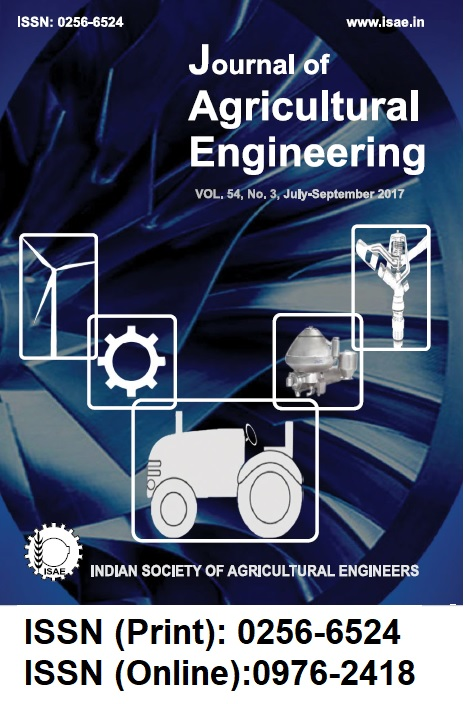Remote Sensing and GIS based Morphometric Analysis for Micro-watershed Prioritization in Takarla-Ballowal Watershed
DOI:
https://doi.org/10.52151/jae2017543.1631Keywords:
Morphometric analysis, prioritization of microwatersheds, remote sensing, GISAbstract
Micro-watershed prioritization has gained importance in watershed management. Morphometric analysis of the Takarla-Ballowal watershed in Shivalik foot-hills of Punjab was carried out using remote sensing and GIS techniques. ASTER data was used for preparing Digital Elevation Model (DEM). The total area of the watershed (2401.82 ha) was divided into 9 micro-watersheds (MWS-1 to MWS-9) with areas ranging from 88.03 ha to 376.72 ha. Drainage density of the micro-watersheds varied from 11.41 km.km-2 (MWS1) to 3.97 km.km-2 (MWS-9), elongation ratio from 0.46 (MWS-8) to 0.80 (MWS-1 and MWS-3), circularity ratio from 0.68 (MWS-1) to 0.34 (MWS-7 and MWS-8), and relief ratio (Rh ) from 0.013(MWS-9) to 0.070 (MWS-3). The length of overland flow varied from 125.94 m (MWS-9) to 43.82 m (MWS-1). Compound morphometric parameter values of the micro-watersheds were determined based on each morphometric parameter value, and the micro-watersheds ranked. The micro-watershed MWS-6 with compound parameter value of 5.7 had lowest priority, while MWS-1 had highest priority with compound parameter value of 4.3, suggesting that MWS-1 was subjected to maximum soil erosion and susceptible to natural hazards. Hence, the micro-watershed MWS-1 should be given top priority for planning and executing conservation treatments.
References
Agarwal C S. 1998. Study of drainage pattern through aerial data in Naugarh area of Varanasi district Uttar Pradesh. J. Ind. Soc. Remote Sens, 26, 169-75.
Anon. 2010. Degraded and Wastelands of India:Status and Spatial Distribution. Indian Council of Agricultural Research, New Delhi, India, pp: 158.
Anon. 2015. Vision 2050. Indian Institute of Soil and Water Conservation, ICAR, Dehradun, Uttarakhand, pp: 35.
Bhardwaj A; Rana D S. 2008. Torrent control measures in Kandi area of Punjab- A case study. J. Water Manage, 16, 55-63.
Bhardwaj A; Kaushal M P. 2009. Two dimensional physically based finite element runoff model for small agricultural watersheds: I. Model development. Hydrol. Process, 23, 397-407.
Biswas S; Sudhakar S; Desai V R. 1999. Prioritisation of sub-watersheds based on morphometric analysis of drainage basin: A Remote Sensing and GIS approach. J. Ind. Soc. Remote Sens, 27, 155-166.
Chandniha S K; Kansal M L. 2014. Prioritization of sub-watersheds based on morphometric analysis using geospatial technique in Piperiya watershed, India. Appl. Water Sci., 5, 230-240.
Chopra R; Dhiman R; Sharma P K. 2005. Morphometric analysis of sub-watershed Gurdaspur district, Punjab using remote sensing and GIS techniques. J. Ind. Soc. Remote Sens, 33, 531-539.
Horton R E. 1932. Drainage basin characteristics. Trans. Ame. Geophys. Union, 13, 350-361.
Horton R E. 1945. Erosional development of streams and their drainage basins hydrophysical approach to quantitative morphology. Geolol. Soc. Ame., 56, 275-370.
Khare D; Mondal A; Kundu S; Mishra P K. 2017. Climate change impact on soil erosion in the Mandakini River Basin, North India. Appl. Water Sci., 7, 2373–2383.
Koshak N; Dawod G. 2011. A GIS morphometric analysis of hydrological catchments within Makkah Metropolitan area, Saudi Arabia. Int. J. Geom. Geosc., 2, 544-54.
Miller V C. 1953. A quantitative geomorphic study of drainage basin characteristics in the Clinch mountain area Virgina and Tennessee. Project NR 389042, Tech. Report no. 3. Department of Geology, Columbia University, New York.
Mishra K; Kumra V K; Mishra S P. 2009. Morphometric analysis and prioritization of micro sub watersheds in Chandraprabha basin. Annuals Natio. Associ. Geogra. Ind, 29, 11-31.
Schumn S A.1956. Evolution of drainage systems and slopes in badlands at Perth Amboy New Jersey. Bull. Geol. Soc. Ame., 67, 597-646.
Sehgal J L; Abrol I P. 1994. Soil Degradation in India: Status and Impact. Oxford and IBH Pub. Co. Pvt. Ltd., New Delhi, India, pp: 80.
Singh G; Babu R; Narian P; Bhushan L S; Abrol I P. 1992. Soil erosion rates in India. J. Soil Water Cons., 47, 97-99.
Singh V; Singh U C. 2011. Basin morphometry of Maingra river district Gwalior Madhya Pradesh India. Int. J. Geoma. Geosc., 1, 891-902.
Singh P; Thakur J K; Singh U C. 2013. Morphometric analysis of Morar river basin in Madhya Pradesh India using remote sensing and GIS techniques. Environ. Earth. Sci., 68, 1967-77.
Smith K G. 1954. Standards for grading texture of erosional topography. Ame. J. Sci., 248, 655-68.
Shrimali S S; Aggarwal S P; Samra J S. 2001. Prioritizing erosion prone areas in hills using remote sensing and GIS – a case study of the Sukhna Lake catchment, Northern India. Int. J. Appl. Earth Obs. Geoinf., 3, 54-60.
Srinivasa V S; Govindaonah S; Home Gowda H. 2004. Morphometric analysis of subwatersheds in the Pawagada area of Tumkur district South India using remote sensing and GIS techniques. J. Ind. Soc. Remote Sens., 32, 351-362.
Strahler A N. 1964. Quantitative Geomorphology of Drainage Basins and Channel Networks. In: Chow V T (Ed.) Handbook Appl. Hydrol., McGraw-Hill Book Company, New York, 4-11.
Surender S; Bhardwaj A; Verma V K. 2016. Hydrological characterization of Dholbaha watershed in Shivalik foot-hills using RS and GIS. J. Agric. Eng., 53, 1-11.
Vittala S; Srinavasa G S; Honnegowda. 2004. Morphometric analysis of sub-watersheds in the Pavagada area Tumkur district south India using remote and GIS techniques. J. Ind. Soc. Remote Sens., 32, 235-51.














